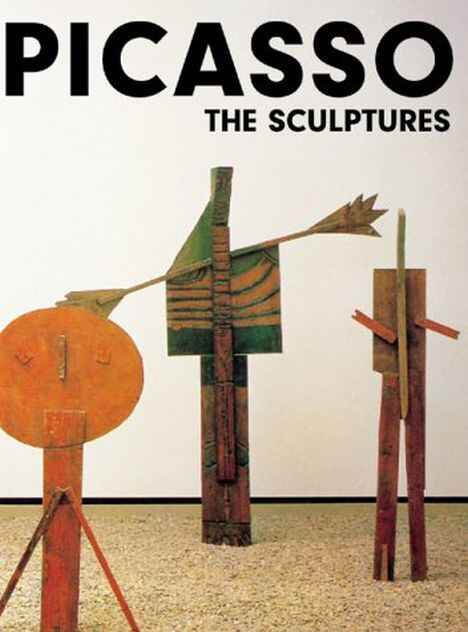
Pablo Picasso (1881-1973) is one of the great artists of the 20th century. The Centre Georges Pompidou in Paris dedicates a comprehensive exhibition to his — despite a publication by Werner Spies in 1970 — unjustly (almost) disregarded sculptures. The substantial catalogue (Amazon.de, Amazon.co.uk, Amazon.com, Amazon.fr) accompanying the retrospective Pablo Picasso — The Sculptures has been put together by Werner Spies. Today, he is the director of the Musée National d’Art Moderne at the Centre Georges Pompidou. The publication illustrates more than 800 sculptures on over 300 pages. In the analytical section, Werner Spies explains Picasso’s way to the sculpture and, chronologically, his artistic evolution through his different periods and styles, which makes this volume the new reference work on the subject. Spies states that the artist’s sculptures have definitively gained their place on an equal level with his paintings and his graphic works. I would even go a step further: although the paintings and graphic works are, from the art history point of view, more important, the sculptures mark the highlights of his career since they better and more openly express his inventive force and his humor than the rest of his oeuvre.
The reception of Picasso’s sculptures began late because Picasso himself had made them one of the best kept art secrets of the 20th century. Until the 1960s, he hid his sculptures away from the public and, until his death in 1973, almost all of the originals remained with him. From his cubistic assemblages and the iron sculptures, which he made from 1929 onwards, almost none was present in museums or collections. At Picasso’s first retrospective in the Galéries Petit in 1932, only seven sculptures were exposed. It was not until the important exhibitions in Paris, London and New York of 1966 and 1967 that he released them into the public space.
The exhibition and the catalogue cover all the spectrum of Picasso’s sculptural work: his early bronzes, the appearance of his cubistic constructions made of metal, wood and found pieces, the filigreed sculptures and the over-life sized heads of the Boisgeloup period, the material assemblies with the “encyclopaedically sculptures” of the 1950s, the tiny figures made of torn and folded paper, and the late, perception challenging folding sculptures made of sheet metal and the use of emptiness in his two-dimensional works.
Until September 30, 2000 the Galerie Art Focus in Zurich displays 58 works by Pablo Picasso. The retrospective chronologically begins with a sketch for La Morte of 1901 (pastel, brush, Indian ink and black grease crayon on paper; 17 x 20 inches) and ends with Couple of 1973 (colored felt-tip pens, black wax pencil, brush, grey and and pencil on paper; 13 3/8 x 10 5/8 inches). Besides works on paper, etchings and prints, the exhibition unites sixteen oil paintings, one bronze, two sheet metal sculptures of 1961 as well as La petite chouette. La petite chouette was on display at the Art Basel 2000 where the gallery sold it for about CHF1 to 1.5 million. The sculpture belongs to Picasso’s assemblages which he began in the early 1940s when he came across an old bicycle saddle and a rusty pair of handlebars on a scrap heap. He immediately put them in his mind to a bull’s head and later executed his vision. His assemblages were a combining of ready-made, sought out objects to form a work of art. Picasso’s objective was on no account to rationally produce a dramatic effect, but to create an object from a spontaneous decision, which expressed his feelings at that particular moment. With La petite chouette Picasso went one step further. He had the idea of creating a sculpture of an owl and scoured rubbish bins and scrap yards, searching for suitable materials. He made his owl entirely from pieces of scrap he had found, including nails, screws, nuts, a pair of pliers and a metal saucepan, which, however, have lost their original appearance but have been skillfully joined together with plaster to give rise to a “realistic” likeness of an owl (Picasso: La petite chouette, 1953. Plaster, terracotta, nails and metal box. 33,5 x 22,5 x 19 cm.).
Catalogue book and exhibition review based on Picasso — The Sculptures at the Centre Georges Pompidou in Paris until September 25, 2000. The catalogue by Werner Spies, Hatje Cantz, 2000, 437 pages with 1220 photographs (192 in color), is essential for the understanding of Picasso, a must. Order the book from Amazon.de, Amazon.co.uk, Amazon.com, Amazon.fr.
The Retrospective at Galerie Art Focus in Zurich until September 30, 2000. Catalogue: Art Focus, 2000, 221 p. Catalogue available at the gallery.

Review added in September 2000.